The Andyson N500 Titanium PSU Review: High Efficiency For The Common PC
by E. Fylladitakis on October 8, 2015 8:00 AM EST- Posted in
- Cases/Cooling/PSUs
- PSUs
- 500W
- Andyson
- 80Plus Titanium
Hot Test Results
Switching over to our hot testing results, as we see in the following tables, the N500 Titanium displays excellent stability and delivers very good power quality, even when thermally stressed. The maximum voltage ripple on the 12V line is 52 mV at maximum load, less than half that of the design limit (120 mV). Strangely, the 3.3V line always displays a ripple of 16 mV, regardless of the unit's load. The maximum recorded ripple on the 5V line is 26 mV, nearly half of the design limit (50 mV).
Voltage regulation is very strong on the 12V line, with a regulation of 0.75% across the load range. On the other hand, the regulation of the minor voltage lines is considerably worse, at 2% across the load range, but that remains a very good performance figure for such a PSU.
| Main Output | ||||||||
| Load (Watts) | 111.18 W | 277.71 W | 414.62 W | 551.13 W | ||||
| Load (Percent) | 20.21% | 50.49% | 75.39% | 100.21% | ||||
| Amperes | Volts | Amperes | Volts | Amperes | Volts | Amperes | Volts | |
| 3.3 V | 1.91 | 3.38 | 4.78 | 3.38 | 7.17 | 3.33 | 9.57 | 3.32 |
| 5 V | 1.91 | 5.16 | 4.78 | 5.12 | 7.17 | 5.07 | 9.57 | 5.05 |
| 12 V | 7.84 | 12.1 | 19.61 | 12.09 | 29.41 | 12.05 | 39.22 | 12.01 |
| Line | Regulation (20% to 100% load) |
Voltage Ripple (mV) | |||||
| 20% Load | 50% Load | 75% Load | 100% Load | CL1 12V |
CL2 3.3V + 5V |
||
| 3.3V | 1.8% | 16 | 16 | 16 | 16 | 16 | 20 |
| 5V | 2% | 20 | 22 | 26 | 26 | 20 | 34 |
| 12V | 0.75% | 30 | 32 | 36 | 52 | 48 | 30 |
We should mention that this PSU does not have a clear temperature rating. This most likely means that it has been rated at 40°C, as this is the commercial computer PSU temperature standard. However, in order to match the 50°C rating of several high-end products, we perform our testing at temperatures higher than 45°C. We could reduce the ambient temperature of our hotbox testing but we chose not to do so as the results would then not be comparable to those of our previous reviews.
According to our results, it does not look like Andyson would have any trouble giving this PSU a clear power output rating at 50°C. The N500 Titanium can maintain its output and strong performance within a very hot environment. It lost only 0.55% of its average energy conversion efficiency, which dropped to 93.55% across the nominal loading range. The drop is evenly distributed across the load range and does not increase in effect as the load increases, suggesting that the PSU's capacity is virtually unaffected by the high environmental temperature.
The internal temperatures of the N500 Titanium do go high with the unit operating inside our hotbox, reaching heatsink temperatures over 80°C at maximum load. Thermal performance is a little worse than before, with widened temperature delta's by about 15%, indicating that the cooling system of the N500 Titanium is getting a little stressed. Still, the fan does not overwork itself. It does spin faster and gets louder than before, but it does not really go over 75% its maximum speed. Apparently, Andyson is not willing to sacrifice the acoustics performance of the PSU unless it is absolutely necessary and these temperatures are not high enough to have an impact on the PSU's longevity or, apparently, its performance.


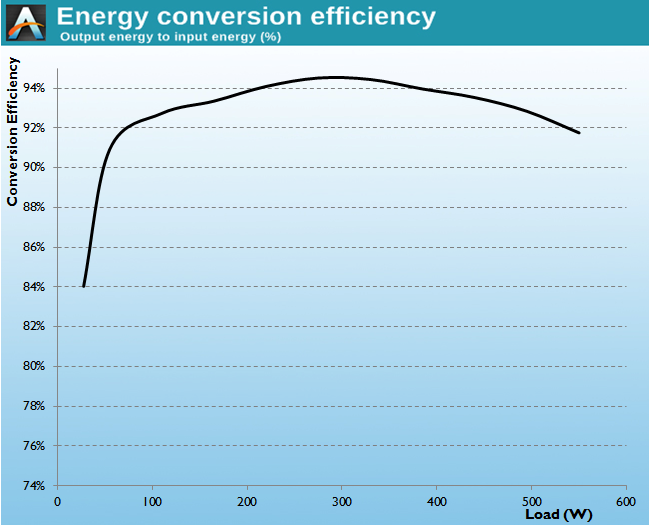
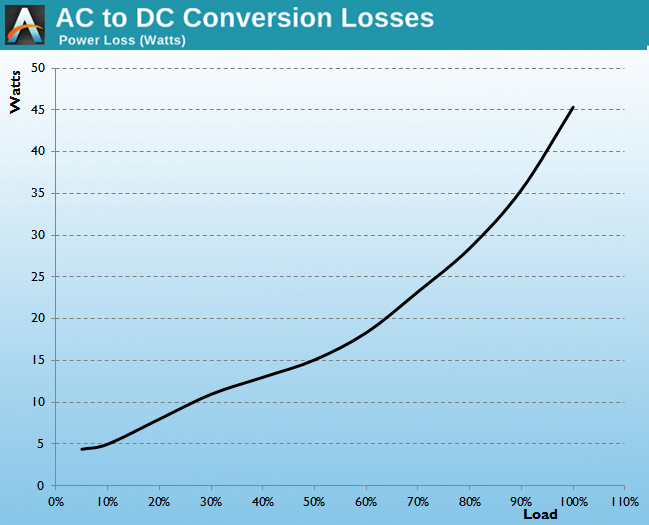
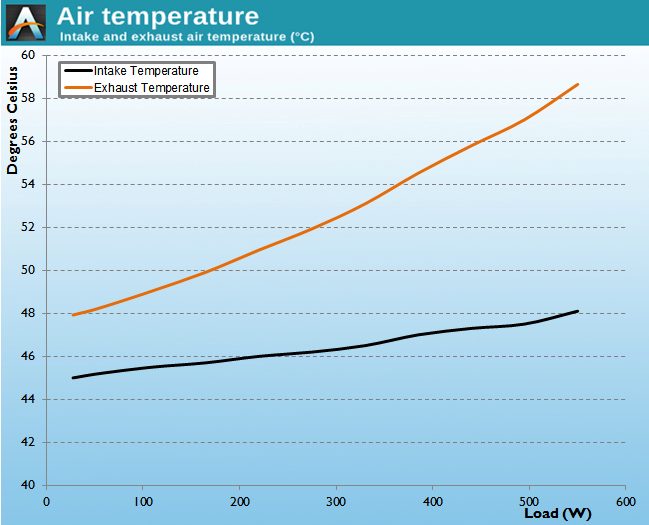
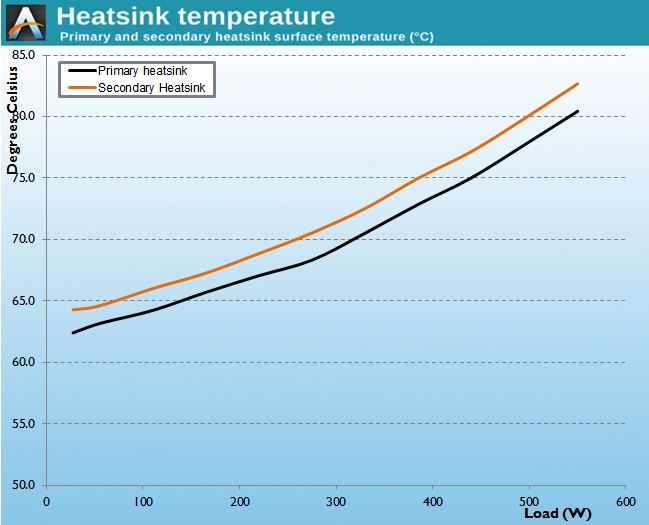
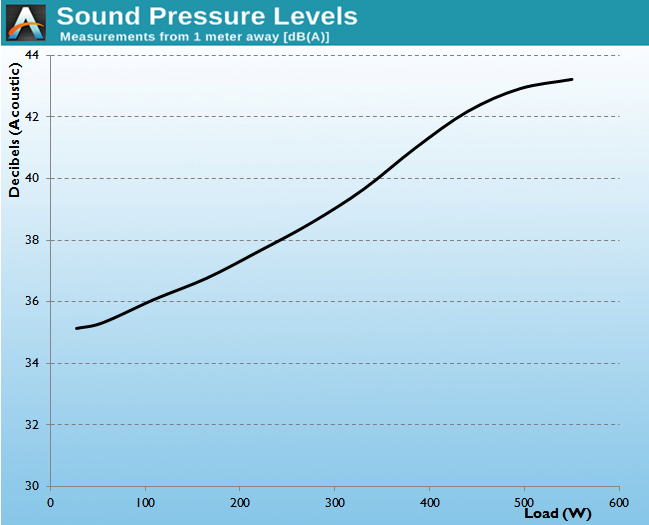








46 Comments
View All Comments
Murloc - Thursday, October 8, 2015 - link
what is 10% when the consumption is low?Also the 80plus certifications are created to take into account that the best efficiency is achieved at certain loads.
This is why they have certifications instead of a single efficiency number.
The consumer gets the information on efficiency synthetized in a single artificial indicator.
CaedenV - Thursday, October 8, 2015 - link
What, you are going to complain about 5w? On a 'normal' PSU you would be looking at 50-60% efficiency at such low loads.HOOfan 1 - Thursday, October 8, 2015 - link
Not sure what you mean by normal. No PSU worth buying on the market today is going to be that inefficient at 50W draw.80 Plus Titanium calls for 90% efficiency at 10% load, so at 50W, this unit should be 90% efficient. None of the other 80+ Certifications specify efficiency at 10% load.
Using Techpowerup, here are some numbers for 80 Plus Gold units.
Seasonic G550 84% efficient at 59W draw retails for $80
EVGA Supernova G2 650 84.77% efficient at 59W draw retails for $100
RussianSensation - Thursday, October 8, 2015 - link
I don't think you know how to reach charts.http://www.anandtech.com/show/9663/the-andyson-n50...
At 50W rating, the power efficiency is >90%.
It seems you also didn't even read the review:
"As expected, the efficiency of the N500 Titanium is astonishing. The unit reached a maximum conversion efficiency of 95.2% at 50% load and an average of 94.1% within the nominal load range (20% to 100% of the unit's capacity). Not only that, but the low load efficiency is comparatively excellent as well, with the N500 Titanium maintaining an energy conversion efficiency of 91.4% at 10% load and 84.6% at 5% load. An efficiency greater than 84% with a load of merely 27.5 Watts on a 500W unit is outstanding."
@ 10% load it's 91.4% to be precise.
Next time before trying to criticize a product, maybe you should actually read the review.
HOOfan 1 - Thursday, October 8, 2015 - link
Are you replying to me or Shadowmaster? I was correcting Shadowmaster when he said it was only 85% efficient at 44w by saying it was at least 90% efficient at 50w. Then I corrected Caedenv when he said other PSUs are only 50% efficient at that losd. So basically if you are refering to me then you just backed up what I already posted...DanNeely - Thursday, October 8, 2015 - link
Actually it is. At idle loads a 80+ Gold PSU would be about 75% efficient; Titanium is the first standard to set a 10% efficiency requirement at all. Squeezing a tenth of a watt of consumption out of fixed power components is much harder than trying to get a tenth of a percent improvement at high loads.DzanZeMan - Thursday, October 8, 2015 - link
Actually, 84.6% effeciency at 5% (27.5 watts) and 91.4% effeciency at 10%. details... details... amirite?RussianSensation - Thursday, October 8, 2015 - link
Exactly. The guy goes off criticizing the product when in the review's description and in the charts it's as clear as can be that at 10% load efficiency is at least 90%.ShieTar - Friday, October 9, 2015 - link
Almost "rite". Its a 500W unit, so 5% are 25W, not 27.5W.Nitpicking, I know ;-)
Samus - Friday, October 9, 2015 - link
Anything over 80% efficiency at <10% load is excellent.85% is unbelievable. As an electrical engineer I can't even wrap my head around how efficient that is. The analog ballasts and transformers I'm used to working with are usually around 70% efficient at idle\no load state. Even a Class 5 transformer to charge your phone saps around half a watt hour without a load, and since those devices are typically 3w, that's about 80% efficient and as good as consumer electronics often get.